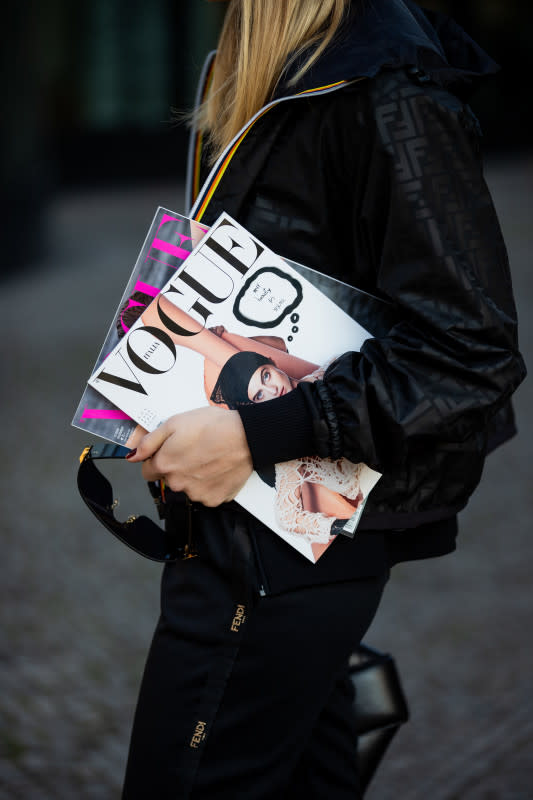What Today's Media Climate Means for Aspiring Fashion Journalists
Journalism has always had its ebbs and flows. But over the past few years, a dark cloud has loomed over the media industry — one that's caused a concern far greater than anything insiders have witnessed before.
Between mass layoffs, publication shutdowns and constant acquisitions, the few available jobs are seemingly the fusion of what once were multiple roles under one title, with little pay. It's alarming not only for those already established in the field, but for the new vanguard of fashion journalists just entering the workforce. It's all sparked a dreadful question: Is this a job still worth pursuing?
"The truth is, there are still jobs in journalism — there are just far fewer of them," says Roger Tredre, course leader in MA Fashion Communication at Central Saint Martins. "What we need to do is face up to [the industry problems], discuss them, not be scared of them, see where the niches and the opportunities still remain and come up with some solutions…We now have to prepare the journalists to use journalistic skills, not necessarily in journalism or fashion journalism, but somewhere in the fashion industry, to some extent."
The real question lies in understanding what fashion media looks like in today's world. Contrary to many Twitter think-pieces, the opportunity is there, it's just a matter of recognizing it in different forms, beyond a traditional magazine.
"Most fashion brands have media brands as well now," Tredre says. "They have their own teams, whether it's doing social media, content for the website, content for brochures or so on. You have hybrid roles in media and marketing — lots of areas of overlap where fashion journalism comes in."
Take for example Net-a-Porter's print product, Porter. Glossier and Ssense have also generated strong branding via self-operated blogs and compelling social content. This results in less dependence on traditional outlets for coverage; however, to Tredre's point, it's ventures like these that up-and-coming writers can tap into to get fashion journalism experience.

Photo: Christian Vierig/Getty Images
Brands relying less and less on magazines is partly due to a restructuring of advertising budgets, once publishing's biggest source of funding. These dollars are being funneled into other ventures, including owned content and promotion initiatives. While this may dry up traditional media money, it forces aspiring professionals to get creative when applying for jobs. Copywriting and brand marketing are two big roles where fashion writers are in demand, according to Kristy Hurt, career consultant and founder of the professional networking group The Co-Lab; public relations, speech writing, crisis communications, human resources and e-commerce are also worth pursuing.
Social media has also been a game-changer, for better or worse. Beyond having access to experienced editors and other fashion industry folks, writers now step into their careers with diversified multimedia skills — like filming, video editing, audio, photography and graphic design — that make them compelling candidates.
Still, this can create challenges, particularly as it pertains to the influencer phenomenon, Emil Wilbekin, journalist and assistant professor in Marketing Communications at the Fashion Institute of Technology (FIT), argues: "Influencers now have so much cache and weight in terms of their reach. Brands are really engaging them around fashion and particularly beauty and accessories and having the influencers make videos and photos."
He continues: "What I'm trying to infuse in my classes is this idea of, as a journalist from a fashion perspective, what platforms are you using to tell your stories? How are you telling stories using the skills of journalism? You should learn how to do podcasts, vlogs and blogging. I try to infuse my students to use their journalistic skills even when they're doing posts on Instagram and TikTok. I think it's about taking the skills of journalism and re-imagining it for today."
Chandra Turner, longtime editor turned recruiter, career coach and founder of Talent Fairy, agrees that social media allows "anybody to become a fashion expert." It's made navigating the already competitive industry even harder, but "it equalizes it in a way too." Instead of relying on connections or excluding people who can't afford to move to New York City for opportunities, "pretty much anyone can come in and make it right."
While media's changing landscape has made the path towards achieving the fashion editor fantasy — think: "Ugly Betty," "The Devil Wears Prada" and "The September Issue" — dispiriting at best, working in the traditional editorial space is still possible. Its true staff sizes are dwindling by the day, but any operating magazine needs consistent traffic, revenue growth and new advertisers, thus requiring writers, editors and directors to produce the accompanying content.
"There's a need and a desire [for great writing and storytelling]," Wilbekin says. "I think we're in a drought in the media industry, but I think that people want real news and real reporting… In a world of fake news, it's very important to have journalists who really understand how to report stories that tell the good, bad and the ugly. We're also seeing a lot of changes within the fashion industry from a business perspective: There are more conglomerates and these head designers are [changing] like almost every season — how people are shopping and engaging with fashion is changing very much so, too."

Photo: Edward Berthelot/Getty Images
Internships and freelancing have proven to be effective paths into full-time fashion media. Paid fashion writing internships are, sadly, still few and far between — especially when companies are already experiencing budget cuts. But Hurt emphasizes "that [internship] experience that you gain is real experience…The person with experience is always going to stand out and have an edge over the person who doesn't."
That's not to say writers should aim to stack their resume with as many internships as possible: Quality should be prioritized over quantity.
"We've all seen those resumes with about 10 one-week internships, and you think, 'Yeah, you made the tea in 10 different offices or sat in the fashion cupboard," Tredre says. "It's cleverer these days to focus on interning somewhere where you really would love to work and you think you might have a genuine chance of working and trying to be there for long enough to make a bit of a difference."
Turner adds that young journalists shouldn't pigeonhole themselves to specific types of internships, either, and instead should "get the widest range of experiences" to "dip their toe into lots of different areas and see what fits."
Being well-versed in emerging technology like artificial intelligence (AI) can help put young writers ahead of the pack. Turner believes that having that knowledge can set someone apart in a job interview: "You can explain that you know how to leverage AI, where it works, where it needs help and get into the checks and balances of it. That's absolutely crucial, because a lot of these administrative jobs that used to be done by assistants have already been replaced by AI."
Those positions, while mostly admin, once allowed entry-level hires to be in the right rooms and learn by osmosis. Networking, however, makes it possible to still get in front of the proper people — after all, no amount of media democratization will ever fully erase the influence of having industry connections.
"People have to know who you are," says Jennifer MacDonald, director of the Center for Graduate Career and Professional Development at The New School. "They have to know that you're looking for an opportunity. And the best way of learning about upcoming opportunities long before they appear in advertising or job databases is through your network. You want to join your alumni association, join a professional association and become an insider so that you're learning about these opportunities before you're in a position where you're trying to find this elusive role and you're applying to hundreds of jobs."
Freelancing has also never been in more demand, though its current landscape is rocky at best. There are known barriers that even experienced journalists endure: chasing invoices, relentless pitching, unstable income. Plus, it can be harder to place a story if a writer doesn't have any bylines or other editors to vouch for them. There's a middle ground in the form of contracted positions: More promising than a temp but less stable than permanent hires, some brands issue short-term contracts that offer steady work on a monthly basis (but usually no insurance or other benefits). While it's far from a sustainable option long-term, it's a viable post-grad segue into media that buys you time to figure out next steps.
Still, even job formats like these speak to what's most important for every young fashion journalist to know: There will always be a place for writers.
"The storytelling is just changing, and the people who adapt to the change are the ones that are going to do well," Turner says. "My head spins at how many different ways there are to create content and distribute content. The players who are distributing it have changed as well. So, if you keep up with it and you actually are energized by the change rather than intimidated by it, you're going to do great."


